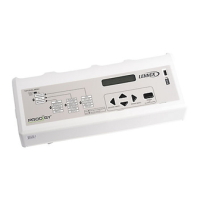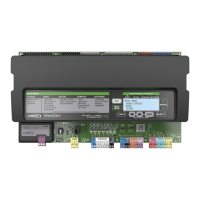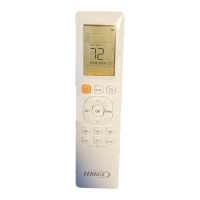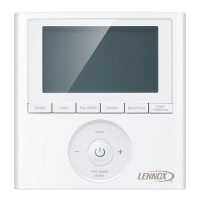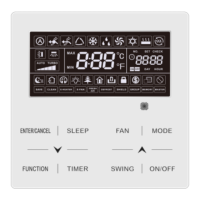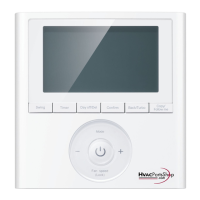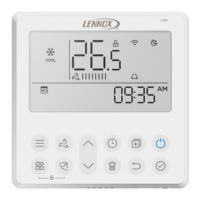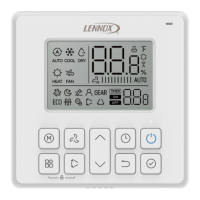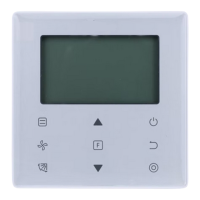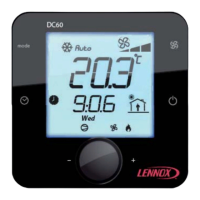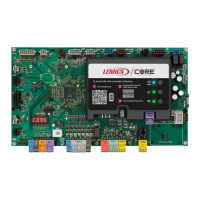11
Table 6. Default Thermostat Mode Operation (Gas Heat) (Energence LG 3 to 25 ton)
No. of Heat Sections Gas Valve W1 Demand W2 Demand
1 (1) 1 Stage Gas Valve 1 Gas Valve 1
1 (1) 2 Stage** Low Rate High Rate
2 (2) 1 Stage High Rate - Both Valves High Rate - Both Valves
2 (2) 2 Stage Low Rate - Both Valves High Rate - Both Valves
** Four and six ton LG units equipped with four stage gas heat employ two stage control from M3 as above.
Table 7. Default Thermostat Mode Operation (Electric Heat) (Energence LC/LG 3 to 25 ton)
No. of Heat Sections Stages Per Section W1 Demand W2 Demand
1 1 Stage 1 Stage 1
1 2 Stage 1 Stage 2
2 1 High Rate - Both Sections High Rate - Both Sections
2 2 Low Rate - Both Sections High Rate - Both Sections
Table 8. Room Sensor Mode Operation (Gas Heat) (Energence LC/LG 13 to 25 ton)
Stage Gas Valve Operation
1 Gas Valve 1 Low Fire
2 Both Gas Valves on Low Fire
3 Gas Valve 1 High Fire and Gas Valve 2 Low Fire
4 Both Gas Valves on High Fire
2.2. System Mode - Room Sensor Backup Mode Set Points
This allows the M3 unit controller to use internal set points and input from a room sensor to operate the unit. An additional
thermostat or energy management system is not required.
2.2.1. Network Control Panel
The set points can also be adjusted using the optional network control panel (NPC). When a NCP is installed, the set
points are determined by its schedule. The NPC communicates with the M3 unit controller via the L Connection network
bus. Internal M3 unit controller set points are used only if network communication is interrupted.
The room sensor is wired directly to each unit P298-6 and P298 -7 (marked GND and TMP on the Field Wiring
Termination Plugs). The room sensor wiring diagram key number is A2.
NOTE: To select either BACnet or LonTalk, Configuration ID 1, position 5 needs to be set to either B for BACnet or L for
LonTalk.
Internal set points can be adjusted using the user interface on the M3 unit controller. In room sensor mode, during the
occupied or unoccupied time period, the default M3 unit controller internal heating and cooling (occupied and
unoccupied) set points as reference in paragraph 2.2.3.
Use parameter stage differential and deadband options to adjust set points in room sensor mode.
2.2.2. Room Sensor Back-Up Modes
Go to SETUP > NETWORK INTEGRATION wizard to configured a back up mode option. Use table 9 to follow the wizard
path to the backup mode setting.
Table 9. Menu Interface (Level 1 - SETUP)
NETWORK
INTEGRATION
NETWORK = RTU
STANDALONE,
L-CONNECTION,
BACNET OR LONTALK
LCONN ADDRESS = X
CONTROL MODE =
ROOM SENSOR OR
NETWORK
THERMOSTAT
NETWORK SENSOR CO2 = YES OR NO
NETWORK SENSOR RELATIVE HUMIDITY = YES OR NO
NETWORK SENSOR TEMPEATURE = YES OR NO
ROOM SENSOR OCC BLOWER MODE= AUTO CYCLES OR ON-
CONTINUOUS 1, 2 OR 3 (SEE NOTE BELOW)
BACKUP MODE = NONE, ROOM SENSOR, RETURN AIR BACKUP
OR THERMOSTAT
BACKUP SETPOINTS OCCUPIED HEAT = XX.X F
BACKUP SETPOINTS UNOCCUPIED HEAT = XX.X F
BACKUP SETPOINTS OCCUPIED COOL = XX.X F
BACKUP SETPOINTS UNOCCUPIED COOL = XX.X F
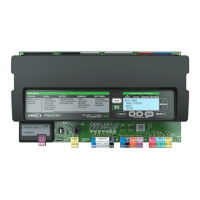
